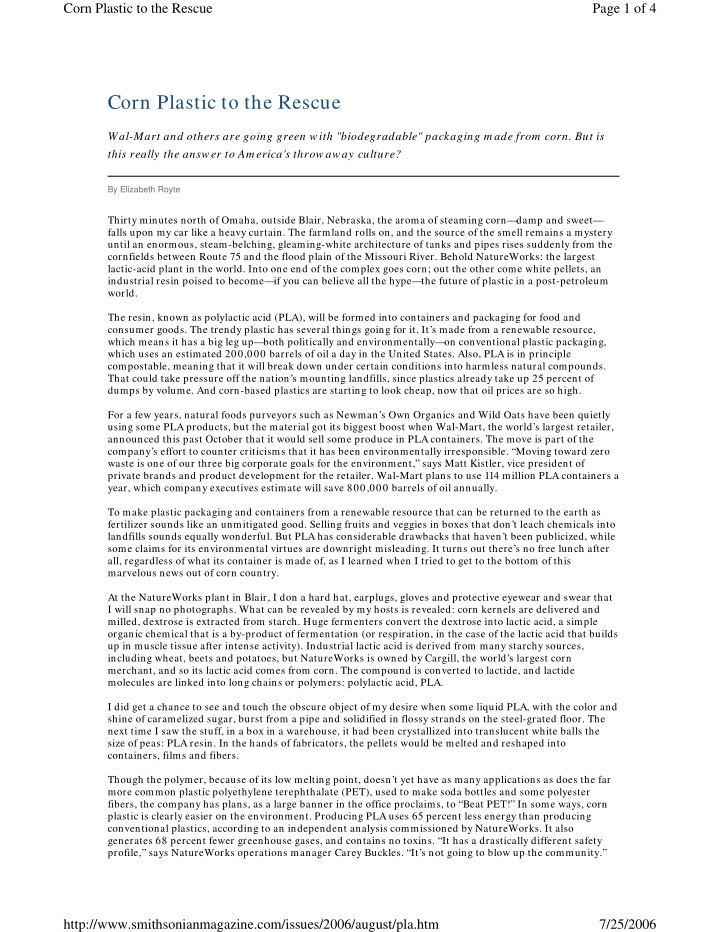



Corn Plastic to the Rescue Page 1 of 4 Corn Plastic to the Rescue Wal-Mart and others are going green w ith "biodegradable" packaging m ade from corn. But is this really the answ er to Am erica's throw aw ay culture? By Elizabeth Royte Thirty minutes north of Omaha, outside Blair, Nebraska, the aroma of steaming corn—damp and sweet— falls upon my car like a heavy curtain. The farmland rolls on, and the source of the smell remains a mystery until an enormous, steam-belching, gleaming-white architecture of tanks and pipes rises suddenly from the cornfields between Route 75 and the flood plain of the Missouri River. Behold NatureWorks: the largest lactic-acid plant in the world. Into one end of the complex goes corn; out the other come white pellets, an industrial resin poised to become—if you can believe all the hype—the future of plastic in a post-petroleum world. The resin, known as polylactic acid (PLA), will be formed into containers and packaging for food and consumer goods. The trendy plastic has several things going for it. It’s made from a renewable resource, which means it has a big leg up—both politically and environmentally—on conventional plastic packaging, which uses an estimated 200,000 barrels of oil a day in the United States. Also, PLA is in principle compostable, meaning that it will break down under certain conditions into harmless natural compounds. That could take pressure off the nation’s mounting landfills, since plastics already take up 25 percent of dumps by volume. And corn-based plastics are starting to look cheap, now that oil prices are so high. For a few years, natural foods purveyors such as Newman’s Own Organics and Wild Oats have been quietly using some PLA products, but the material got its biggest boost when Wal-Mart, the world’s largest retailer, announced this past October that it would sell some produce in PLA containers. The move is part of the company’s effort to counter criticisms that it has been environmentally irresponsible. “Moving toward zero waste is one of our three big corporate goals for the environment,” says Matt Kistler, vice president of private brands and product development for the retailer. Wal-Mart plans to use 114 million PLA containers a year, which company executives estimate will save 800,000 barrels of oil annually. To make plastic packaging and containers from a renewable resource that can be returned to the earth as fertilizer sounds like an unmitigated good. Selling fruits and veggies in boxes that don’t leach chemicals into landfills sounds equally wonderful. But PLA has considerable drawbacks that haven’t been publicized, while some claims for its environmental virtues are downright misleading. It turns out there’s no free lunch after all, regardless of what its container is made of, as I learned when I tried to get to the bottom of this marvelous news out of corn country. At the NatureWorks plant in Blair, I don a hard hat, earplugs, gloves and protective eyewear and swear that I will snap no photographs. What can be revealed by my hosts is revealed: corn kernels are delivered and milled, dextrose is extracted from starch. Huge fermenters convert the dextrose into lactic acid, a simple organic chemical that is a by-product of fermentation (or respiration, in the case of the lactic acid that builds up in muscle tissue after intense activity). Industrial lactic acid is derived from many starchy sources, including wheat, beets and potatoes, but NatureWorks is owned by Cargill, the world’s largest corn merchant, and so its lactic acid comes from corn. The compound is converted to lactide, and lactide molecules are linked into long chains or polymers: polylactic acid, PLA. I did get a chance to see and touch the obscure object of my desire when some liquid PLA, with the color and shine of caramelized sugar, burst from a pipe and solidified in flossy strands on the steel-grated floor. The next time I saw the stuff, in a box in a warehouse, it had been crystallized into translucent white balls the size of peas: PLA resin. In the hands of fabricators, the pellets would be melted and reshaped into containers, films and fibers. Though the polymer, because of its low melting point, doesn’t yet have as many applications as does the far more common plastic polyethylene terephthalate (PET), used to make soda bottles and some polyester fibers, the company has plans, as a large banner in the office proclaims, to “Beat PET!” In some ways, corn plastic is clearly easier on the environment. Producing PLA uses 65 percent less energy than producing conventional plastics, according to an independent analysis commissioned by NatureWorks. It also generates 68 percent fewer greenhouse gases, and contains no toxins. “It has a drastically different safety profile,” says NatureWorks operations manager Carey Buckles. “It’s not going to blow up the community.” http://www.smithsonianmagazine.com/issues/2006/august/pla.htm 7/25/2006
Recommend
More recommend